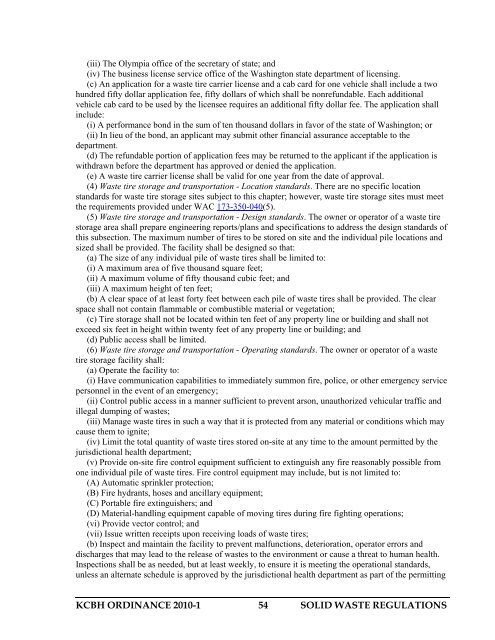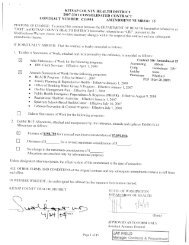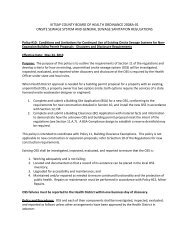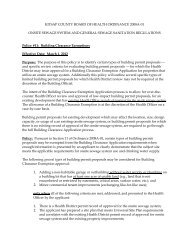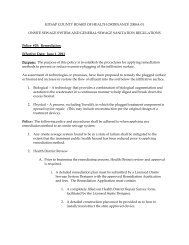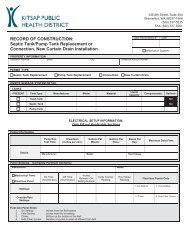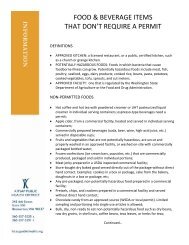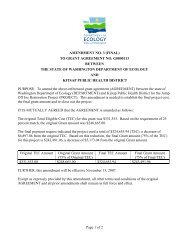SOLID WASTE REGULATIONS - Kitsap Public Health District
SOLID WASTE REGULATIONS - Kitsap Public Health District
SOLID WASTE REGULATIONS - Kitsap Public Health District
You also want an ePaper? Increase the reach of your titles
YUMPU automatically turns print PDFs into web optimized ePapers that Google loves.
(iii) The Olympia office of the secretary of state; and<br />
(iv) The business license service office of the Washington state department of licensing.<br />
(c) An application for a waste tire carrier license and a cab card for one vehicle shall include a two<br />
hundred fifty dollar application fee, fifty dollars of which shall be nonrefundable. Each additional<br />
vehicle cab card to be used by the licensee requires an additional fifty dollar fee. The application shall<br />
include:<br />
(i) A performance bond in the sum of ten thousand dollars in favor of the state of Washington; or<br />
(ii) In lieu of the bond, an applicant may submit other financial assurance acceptable to the<br />
department.<br />
(d) The refundable portion of application fees may be returned to the applicant if the application is<br />
withdrawn before the department has approved or denied the application.<br />
(e) A waste tire carrier license shall be valid for one year from the date of approval.<br />
(4) Waste tire storage and transportation - Location standards. There are no specific location<br />
standards for waste tire storage sites subject to this chapter; however, waste tire storage sites must meet<br />
the requirements provided under WAC 173-350-040(5).<br />
(5) Waste tire storage and transportation - Design standards. The owner or operator of a waste tire<br />
storage area shall prepare engineering reports/plans and specifications to address the design standards of<br />
this subsection. The maximum number of tires to be stored on site and the individual pile locations and<br />
sized shall be provided. The facility shall be designed so that:<br />
(a) The size of any individual pile of waste tires shall be limited to:<br />
(i) A maximum area of five thousand square feet;<br />
(ii) A maximum volume of fifty thousand cubic feet; and<br />
(iii) A maximum height of ten feet;<br />
(b) A clear space of at least forty feet between each pile of waste tires shall be provided. The clear<br />
space shall not contain flammable or combustible material or vegetation;<br />
(c) Tire storage shall not be located within ten feet of any property line or building and shall not<br />
exceed six feet in height within twenty feet of any property line or building; and<br />
(d) <strong>Public</strong> access shall be limited.<br />
(6) Waste tire storage and transportation - Operating standards. The owner or operator of a waste<br />
tire storage facility shall:<br />
(a) Operate the facility to:<br />
(i) Have communication capabilities to immediately summon fire, police, or other emergency service<br />
personnel in the event of an emergency;<br />
(ii) Control public access in a manner sufficient to prevent arson, unauthorized vehicular traffic and<br />
illegal dumping of wastes;<br />
(iii) Manage waste tires in such a way that it is protected from any material or conditions which may<br />
cause them to ignite;<br />
(iv) Limit the total quantity of waste tires stored on-site at any time to the amount permitted by the<br />
jurisdictional health department;<br />
(v) Provide on-site fire control equipment sufficient to extinguish any fire reasonably possible from<br />
one individual pile of waste tires. Fire control equipment may include, but is not limited to:<br />
(A) Automatic sprinkler protection;<br />
(B) Fire hydrants, hoses and ancillary equipment;<br />
(C) Portable fire extinguishers; and<br />
(D) Material-handling equipment capable of moving tires during fire fighting operations;<br />
(vi) Provide vector control; and<br />
(vii) Issue written receipts upon receiving loads of waste tires;<br />
(b) Inspect and maintain the facility to prevent malfunctions, deterioration, operator errors and<br />
discharges that may lead to the release of wastes to the environment or cause a threat to human health.<br />
Inspections shall be as needed, but at least weekly, to ensure it is meeting the operational standards,<br />
unless an alternate schedule is approved by the jurisdictional health department as part of the permitting<br />
KCBH ORDINANCE 2010-1 54 <strong>SOLID</strong> <strong>WASTE</strong> <strong>REGULATIONS</strong>


